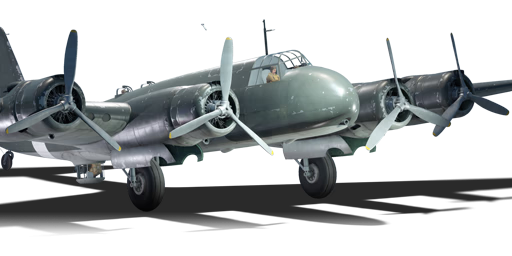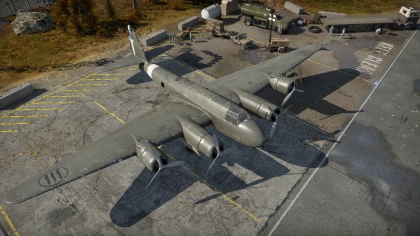Difference between revisions of "P.108A serie 2"
(→Details: Added missing table) |
m (can't carry bombs) (Tag: Visual edit) |
||
| Line 189: | Line 189: | ||
* Massive target | * Massive target | ||
* Prone to fuel tank fire due to tremendous fuel load | * Prone to fuel tank fire due to tremendous fuel load | ||
| + | * can't carry bombs | ||
== History == | == History == | ||
Revision as of 11:26, 15 December 2020
Contents
| This page is about the Italian attacker P.108A serie 2. For the bombers, see P.108B serie 1 and P.108B serie 2. |
Description
The P.108A serie 2 is a rank I Italian attacker
with a battle rating of 1.7 (AB), 2.3 (RB), and 3.0 (SB). It was introduced in Update 1.69 "Regia Aeronautica". It features a 102 mm cannon in its fuselage, one of the largest armament placed onto an aircraft.
The P.108A serie 2 is your normal P.108, but with a 102 mm anti-shipping gun containing 50 rounds. In saying that, you're basically an over-sized Hs 129 or PBJ-1H. The main reason for not seeing the aircraft on Air AB, RB or even Sim is due to the fact the plane is demanding on takeoff due to its low horsepower engines and will not take off if combat flaps or take-off flaps are down (if you don't, it's going to be quite hard to take off). The defensive weaponry is decent for its battle rating but will not survive if it get uptiered to 4.3.
General info
Flight performance
It is difficult to compliment the P.108A's flight performance. It is for all intents and purposes a heavy bomber repurposed into an attacker. It flies somewhat acceptably compared to other bombers but by attacker standards it is terrible. It is slow, turns poorly, and does not accelerate or climb well at all. Roll rate and energy retention are not worth mentioning. The sheer weight and bulk of the plane give it a large amount of inertia. Getting guns on target during a strafing run can be a major challenge due to its weak rudder and extremely sluggish controls, and once its altitude is expended, there is little chance of getting it back in a timely manner. Think twice before attacking a ground or naval target and avoid steep dives. There are better uses of your time than fighting with the P.108A's controls in a futile attempt to pull up!
| Characteristics | Max Speed (km/h at 3,049 m) |
Max altitude (metres) |
Turn time (seconds) |
Rate of climb (metres/second) |
Take-off run (metres) | |||
|---|---|---|---|---|---|---|---|---|
| AB | RB | AB | RB | AB | RB | |||
| Stock | 426 | 412 | 7500 | 32.5 | 34.1 | 6.0 | 5.9 | 750 |
| Upgraded | 464 | 444 | 29.6 | 31.0 | 9.8 | 7.7 | ||
Details
| Features | ||||
|---|---|---|---|---|
| Combat flaps | Take-off flaps | Landing flaps | Air brakes | Arrestor gear |
| ✓ | ✓ | ✓ | X | X |
| Limits | ||||||
|---|---|---|---|---|---|---|
| Wings (km/h) | Gear (km/h) | Flaps (km/h) | Max Static G | |||
| Combat | Take-off | Landing | + | - | ||
| 515 | 290 | 400 | 400 | 249 | ~3 | ~2 |
| Optimal velocities (km/h) | |||
|---|---|---|---|
| Ailerons | Rudder | Elevators | Radiator |
| < 330 | < 310 | < 270 | > 250 |
Survivability and armour
- 8 mm Steel - Cockpit armour - instrument panel, pilot's seat, co-pilot's seat and floor plate below pilot
- 8 mm Steel - Armour plate protecting ammo located in wings
- 8 mm Steel - Side gunner armoured walls
- 8 mm Steel - Ventral gunner position
- Fuel tanks located in wings
Armaments
Offensive armament
The P.108A serie 2 is armed with:
- 1 x 102 mm 102/35 mod 14 cannon, nose-mounted (50 rpg)
Defensive armament
The P.108A serie 2 is defended by:
- 2 x 12.7 mm Breda-SAFAT machine gun, 2 x wing turret (300 rpg = 1,200 total)
- 1 x 12.7 mm Breda-SAFAT machine gun, ventral turret (450 rpg)
- 1 x 7.7 mm Breda-SAFAT machine gun, 2 x beam turret (400 rpg = 800 total)
Usage in battles
The Piaggio P.108A Serie 2 is a 4 engine attacker. Despite being an attacker, the 102 mm cannon is relatively inaccurate which means the targets that suit this plane the best are usually stationary targets that the 102 mm cannon can penetrate and destroy. The plane's defensive firepower is relatively poor and you should try to avoid enemy planes as much as possible. If an enemy plane is lining up to attack you from the front, try to swing your plane and give him the tail of the plane so your gunners can shoot back at the enemy aircraft.
Stay low and do not go above 1,900 m. Speed is key: try to maintain a speed of close to 200 km/h as that gives you wiggle room as your stall speed is 155 km/h despite the massive weight.
Manual Engine Control
| MEC elements | ||||||
|---|---|---|---|---|---|---|
| Mixer | Pitch | Radiator | Supercharger | Turbocharger | ||
| Oil | Water | Type | ||||
| Controllable | Controllable Auto control available |
Controllable Not auto controlled |
Controllable Not auto controlled |
Separate | Not controllable 1 gear |
Auto controlled |
Modules
| Tier | Flight performance | Survivability | Weaponry | ||
|---|---|---|---|---|---|
| I | Fuselage repair | Radiator | Turret 7 mm | ||
| II | Compressor | Airframe | New 7 mm MGs (turret) | Offensive 102 mm | |
| III | Wings repair | Engine | Turret 12 mm | ||
| IV | Engine injection | Cover | New 12 mm MGs (turret) | New 102 mm cannons | |
- The first tier modifications to be unlocked should be Radiator and Fuselage repair, then Turret 7 mm. This is so you can improve the poor performance of the plane. The belts should be last as no matter what the defensive firepower of the plane with or with out the belts would still remain poor.
- The second tier upgrades should start with the Airframe so your plane is a bit more durable. Then get the New 7 mm MGs (turret) and Offensive 102 mm for increase in firepower and defensive armament. Finally go get the Compressor.
- The Third tier modifications should start off with the Engine, then unlock the Wings repair. Last of all unlock the Turret 12.7 mm.
- The fourth tier modification should start off with the New 12.7 mm MGs (turret) then Cover. And your last two modification should be Engine Injection and New 102 mm Cannons.
Pros and cons
Pros:
- 102 mm cannon can prove devastating on a direct hit
- Large amount of ammo for the cannon
- 2 turrets are placed on the distant engines allowing for more guns to face backwards
- Repair cost is negligible (less than 1000 SL)
- High SL multiplier
Cons:
- Inaccurate cannon and sluggish airframe make lining up shots very difficult
- Gunners are bunched together and easily knocked out
- Turrets on the engines cannot face forwards
- Relatively weak defensive armament
- Head on attacks are usually fatal for this plane
- Massive target
- Prone to fuel tank fire due to tremendous fuel load
- can't carry bombs
History
The Piaggio P.108 heavy bomber series were the only strategic bombers to see service with the Italian military during World War II. The P.108 was developed prior to the war as a continuation of the earlier prototype Piaggio P.50. With long range and considerable bombload, the P.108 was supposed to offer the Regia Aeronautica the ability to attack ships and bases throughout the Mediterranean region, particularly at Gibraltar. The resulting aircraft was fairly advanced by the standards of the Italian industry, featuring all-metal construction, electric welding, and remote-control gun turrets on the outer engine nacelles. It looked somewhat like an Italian equivalent of the American B-17 Flying Fortress, which itself had been considered for license production in Italy. The P.108 first flew in late 1939.
The P.108 had its fair share of issues, largely related to its engines. During one test flight in February 1941, all four Piaggio R.XI engines of the P.108 prototype failed due to heavy icing. The pilot miraculously made a safe emergency landing. Later examples switched to the Piaggio R.XXII engine instead. The reputation of the bomber also took a hit when Bruno Mussolini, the son of Italian dictator Benito Mussolini and the commander of a P.108 crew, died after a crash on August 7, 1941 caused by hydraulic and engine failure shortly after takeoff. The P.108 only entered combat service in 1942 and saw middling success at first; engine troubles aside, Italian crews were not prepared for the navigation and fuel management challenges that long range bombing missions entailed. By 1943, the P.108s began to encounter stiff resistance from enemy aircraft and several were lost to British fighters. After the Italian armistice, the remaining P.108s saw little service. The transport versions served to the end of the war.
The P.108A was a curious modification of the P.108B bomber variant developed in late 1942. It was designed to attack ships, and to this end it was equipped with an enormous 102 mm cannon in the lower part of the nose. The cannon was a bored-out development of the 90/53 cannon used by the Italian Army, capable of firing larger shells. The installation added two tons of weight to the P.108. The airframe was revised and a special gun sight was installed, later including an analog computer. The P.108A underwent extensive testing and was deemed an effective anti-ship attacker. Plans were made to assemble 5 additional P.108As for a dedicated attack unit, but the Italian armistice halted them. Thus, only one P.108A was ever built. It fell into German hands and was evaluated by the Luftwaffe at their test center in Rechlin, Germany. It was damaged and later destroyed by Allied bombing some time after 1944.
The P.108 did not make a significant impact in World War II, only being produced in small numbers and encountering many obstacles during testing and operational use. It was used in Gibraltar, North Africa, and Sicily with mixed results. The P.108A avoided the developmental troubles of the bomber versions but never entered service, and the single prototype never fired its gun in anger. In spite of its faults, the P.108 can be credited with being the pinnacle of Italian bombers. It served as a basis for the improved P.133 design, which promised superior performance and armament but was canceled after the armistice and never built.
No P.108s are known to survive today.
Media
See also
Links to the articles on the War Thunder Wiki that you think will be useful for the reader, for example:
- reference to the series of the aircraft;
- links to approximate analogues of other nations and research trees.
External links
Paste links to sources and external resources, such as:
- topic on the official game forum;
- encyclopedia page on the aircraft;
- other literature.
| Piaggio Aero | |
|---|---|
| Attackers | P.108A serie 2 |
| Bombers | P.108B serie 1 · P.108B serie 2 |
| Italy strike aircraft | |
|---|---|
| Ba.65 (K.14) L · Breda 88 (P.XI) · F.C.20 Bis · P.108A serie 2 | |
| Ro.57 Quadriarma · SM.91 · SM.92 | |
| Hungary | ◐Bf 110 G-4 · ◔IL-10 |
| Romania | Hs 129 B-2 (Romania) |





